43 episodes

Jason Eyre: the philosophy of Learning Development
18/12/2025 | 1h 16 mins.
What has philosophy got to do with learning development? And why should learning development be concerned with philosophy? For Jason Eyre – indeed, for all philosophers – philosophy gives us new ways to think about things and new concepts we can work with, to understand not necessarily the answer to a question (such as, What is LD?) but alternative ways we can engage with that question. Jason (with some help from his cat, Peppercorn, who you might hear in this episode) wants LD to consider its tendencies more than its boundaries, its connectedness more than its categories. When we don’t pin something down, we can focus instead on our commonalities. The world is ever changing and higher education changes with it; rather than be left behind in our rigid definitions, by situating ourselves in our contexts we can stay responsive. And by keeping our emphasis on relationality, and the communities in which we work, we can find resilience in each other, boost each other’s agency, and discover joy. Surely such a gift is worth spending some time with Deleuze? Failing that, spend it with Jason; you won’t regret it. The resources we mentionedDhillon, S. (2025). Book review: Eyre, J. (2025) Learning Development in higher education: crisis, practice, and power in the 21st century university. Singapore: Springer. Journal of Learning Development in Higher Education, (38). https://doi.org/10.47408/jldhe.vi38.1819Didion, J. (2021). Why I write. Literary Hub. Available at: https://lithub.com/joan-didion-why-i-write/ Spinoza: a useful introduction is available from the Stanford Encyclopedia of Philosophy. You might find the section on Virtue and Happiness particularly useful. For an introduction to the concept of the virtual vs the actual, as conceived by Bergson and developed by Deleuze, this short article in Epoche Magazine will give you plenty of text to dwell with!And the publication we talked aboutEyre, J. (2025). Learning Development in Higher Education: Crisis, Practice, and Power in the 21st Century University. Springer, https://doi.org/10.1007/978-981-96-8802-9

Edward Venn: building a sense of belonging
28/11/2025 | 1h 9 mins.
Belonging is one of those abstract concepts that seems to be something whose meaning we can all relatively easily grasp, but when we come to look at it more closely, actually appears to be much more slippery and elusive. Belonging itself is an objective fact about an individual’s membership of a group or community. A sense of belonging – that mysterious element that occupies us in this conversation – is that individual’s subjective relationship with the group or community to which they belong. So before we can measure or even examine someone’s sense of belonging, we must first ensure we know what we are talking about, and that that person shares that understanding. And what would we do with that measurement, anyway? A lack of sense of belonging is not an easy fix, and not something that everyone would want fixed, anyway; a sense of belonging is not obligatory, nor is its lack necessarily a problem. Why worry about it, then? Because the Venn diagram of sense of belonging and engagement has a large intersection, and therefore, in the eyes of this particular Venn, a problem worth solving.The resources we mentionedBooth, W.C. (1995). The craft of research. The University of Chicago Press. NB 1st edition recommended - try World of Books!Kaminski, R. (2025). The gift of not belonging: How outsiders thrive in a world of joiners. Scribe.Chapters specifically mentioned by Ed from his book are those by:Stacey Mottershaw, Rachael O'Connor, Nadine Cavigioli: A collaborative autoethnographic reflection on social class and student belonging in higher educationKathleen Quinlan: Belonging and engagement in higher education literatureAyoola Johnson: Seeking belonging in higher educationTerrell Strayhorn: Social engagement and students’ sense of belongingEdward Venn, Karen Burland, Boroka Javor: Challenging dominant discoursesAnd the publication we talked aboutAhn, M.Y, Venn, E. and Lowe, T. (Eds.) (2025). Student Belonging in Higher Education: Perspectives and Practice. Routledge.

Lisa Clughen: embodied learning for joyful learning
16/10/2025 | 1h 19 mins.
How do we make the body not only our partner in learning, but our friend? And why would we even want to? The mind-body dualism espoused by Descartes in the 17th century continues to influence our thinking today, with the body – or more specifically, the emotions it houses – often represented as an obstacle to rational thought and therefore its enemy. This is little more than an enduring misogyny that positions emotions – the body – as feminine, irrational, and undesirable, and thought – the mind – as masculine, rational, and desirable. Yet we are all subject to this discourse, all of us alienated by western culture from our bodies and our emotions. Some of us find our way back, to connect what Lisa Clughen cites as ‘the intelligence of the flesh’ with cognition. Lisa strongly believes we should celebrate our embodiment and recognise its centrality to our learning and thinking processes. How many of us have walked or moved to help ease a thought into consciousness? How many have felt the excitement, the joy, when someone has praised something we have done? Similarly, we can aim to induce feelings of awe, interest, joy, amusement in our students to stimulate an emotional and more memorable response to their learning. And perhaps in doing so we can reconnect with our own bodies and our own emotions, and truly engage with the joy of learning and teaching. The resources we mentionedBordo, S. (1993). Unbearable weight: Feminism, Western culture and the body. University of California Press. Clughen, L. (2002), ‘Lorca's anorexics: hunger strike in the cause of selfhood’, Bulletin of Hispanic Studies, 79: 3, pp. 309-324. https://doi.org/10.3828/bhs.79.3.4 Clughen, L. (2014). ‘Embodied writing support’: the importance of the body in engaging students with writing. Journal of Writing in Creative Practice 7(2), pp.283-300. Available from: https://www.advance-he.ac.uk/knowledge-hub/embodied-writing-support-lisa-clughenDana, D. Rhythm of regulation. Available from https://www.rhythmofregulation.com/glimmers Elbow, P. (2012). Vernacular eloquence: What speech can bring to writing. Oxford University Press. Forster, E.M. (1909). The machine stops. Available from: https://www.cs.ucdavis.edu/~koehl/Teaching/ECS188/PDF_files/Machine_stops.pdf Fredrickson, B.L. (2004). The broaden-and-build theory of positive emotions. Philosophical Transactions of the Royal Society of London B, Biological Sciences 359(1449): 1367-78. doi: 10.1098/rstb.2004.1512Grosz, E. (1995). Space, time and perversion: The politics of bodies. Routledge. hooks, b. (1994). Teaching to transgress: education as the practice of freedom. Taylor and Francis.Immordino‐Yang, M. and Damasio, A. (2007) We feel, therefore, we learn: the relevance of affective and social neuroscience to education. Mind, Brain, and Education, 1(1), pp.3-10.Available at: https://doi.org/10.1111/j.1751-228X.2007.00004.xNeff, K. Self-compassion on her YouTube channel: https://www.youtube.com/@NeffKristin Orbach, S. (2010). Bodies. Profile BooksRogers, C. ‘The Interpersonal Relationship in the Facilitation of Learning’, In M. Thorpe, R. Edwards and A. Hanson (eds.), Culture and Processes of Adult Learning, London and New York: Open University, (1993 (first published in 1967)), pp. 228242. Shilling, C. (1993). The body and social theory: Theory, culture and society. Sage PublicationsSuzuki, W. (2015). Healthy brain, happy life. Dey Street Books.Woolf, V. (1930). Streethaunting: A London adventure. Available from: https://www.literaturecambridge.co.uk/news/street-haunting And the article we talked aboutClughen, L. (2025). Eros in the classroom and beyond: cultivating positive emotions for learning, teaching and wellbeing in higher education. Journal of Learning Development in Higher Education, (35). https://doi.org/10.47408/jldhe.vi35.1348

James Lang: cultivating attention
18/9/2025 | 1h 6 mins.
Learning does not happen without attention. But in a world so full of distractions, how can we ensure our students are paying attention? For Professor James Lang, the answer lies in deliberating cultivating attention in our students, rather than trying to limit distractions. And how do we do that? Think about what makes you pay attention. How do you help yourself focus? How, then, can you create these conditions for others? The key is to remember that attention is personal: not just in the sense that we all have our own interests, but also in that we need to create space in the subject for the individual. When we can see ourselves, or a connection to ourselves, in what we are learning, it is easier to be drawn into the material. Above all, paying attention brings joy, and as educators there is surely no greater joy than in deliberately creating those moments for others!The resources we mentionedGermano, W. 2016. Getting It Published: A Guide for Scholars and Anyone Else Serious about Serious Books, (3rd ed.). University of Chicago Press.Lamott, A. 1995. Bird by Bird: Some Instructions on Writing and Life. Anchor Books.Jim’s personal website: https://www.jamesmlang.com/ Jim’s substack, A General Education: https://jamesmlang.substack.com/ Jim’s podcast, Designed for LearningMiller, M.D. 2024. A Teacher’s Guide to Learning Student Names: Why You Should, Why It’s Hard, How You Can. University of Oklahoma Press.Sword, H. 2012. Stylish academic writing. Harvard University Press.Sword, H. 2017. Air & Light & Time & Space. Harvard University Press.And the publications we talked aboutLang, J. M. (2020) Distracted: Why students can't focus and what you can do about it. Hachette UK.Lang, J. M. (2025) Write Like You Teach: Taking Your Classroom Skills to a Bigger Audience. University of Chicago Press.

Lily Abadal: the value of slow thinking
22/8/2025 | 1h
The eruption of generative AI into higher education prompted many educators, worried about the integrity of their courses (and the personal integrity of their students), to redesign their assessments, rejecting essays and other long-form pieces of writing in favour of ‘AI-proof’ reflective pieces or so-called authentic assessment formats instead. Lily Abadal, in contrast, believes not only that writing has deep implicit value in learning, but that it can be meaningfully achieved in a way that circumvents the temptations of AI. Engaging in a topic in depth, mulling over an issue, considering an argument, and then sitting with the discomfort of not having a clear and quick answer can all be difficult and uncomfortable. By learning how to think slowly and deeply, students come to understand that the discomfort is itself a sign of learning; designing these opportunities out serves no one. When we slow down, when we look for the meaning beyond the output, we can reconnect with our thought processes and relish the pleasure of learning. The resources we mentionedAbadal, L.M. (2025) Only the Humanities can save the university from AI. Public Discourse, 21 July. Available from: https://www.thepublicdiscourse.com/2025/07/98429/ Lily’s website: https://www.drlilyabadal.com/ Hadot, P. (1995). Philosophy as a Way of Life: Spiritual Exercises from Socrates to Foucault. Wiley-Blackwell.James Lang’s articles on The Chronicle of Higher Education. Pascal’s WagerStrunk, W. and White, E.B. (1999) The Elements of Style (4th ed.). Pearson.Syska, A. (2025). We tried to kill the essay - now let’s resurrect it. The LSE Blog, 27 February. Available from: https://blogs.lse.ac.uk/highereducation/2025/02/27/we-tried-to-kill-the-essay-now-lets-resurrect-it/ And the publications we talked aboutAbadal, L.M. (2025) Drafted: A Workbook for Slow Thinking in the Age of AI. Available from: https://www.drlilyabadal.com/drafted-workbook.html Abadal, L.M. (2024) 'Ensuring genuine assessment in philosophy education: strategies for scaffolding writing assessment in an LLM era', Teaching Philosophy, 47(1), pp. 143-165. doi: 10.5840/teachphil2024422195.
More Education podcasts
Trending Education podcasts
About The Learning Development Project
Listen to The Learning Development Project, Begin Again with Davina McCall and many other podcasts from around the world with the radio.net app

Get the free radio.net app
- Stations and podcasts to bookmark
- Stream via Wi-Fi or Bluetooth
- Supports Carplay & Android Auto
- Many other app features
Get the free radio.net app
- Stations and podcasts to bookmark
- Stream via Wi-Fi or Bluetooth
- Supports Carplay & Android Auto
- Many other app features


The Learning Development Project
download the app,
start listening.


































